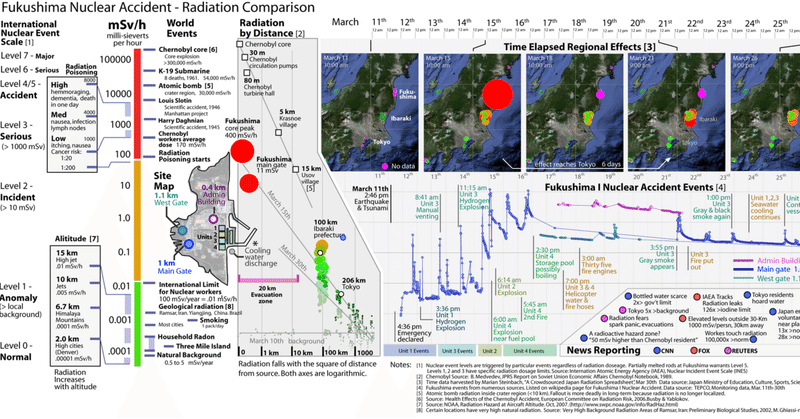
MegaQuake(jp:巨大地震)3.11
2011 Tōhoku earthquake and tsunami
Great East Japan Earthquake(jp:東日本大震災)
On 11 March 2011, at 14:46 JST (05:46 UTC)
The disaster is often referred to by its numerical date, 3.11
Magnitude: 9.0 (the largest earthquake recorded in Japan)
JMA Seismic Intensity: 7 (max: Kurihara City, Miyagi Prefecture)

https://www.youtube.com/watch?v=yK5cE_w4bhQ
MegaQuake: Hour That Shook Japan | Disaster Documentary
●Casualties and Damages
Human Casualties
Deceased: 19,729
Missing: 2,559
Injured: 6,233
Damaged Buildings
Completely destroyed: 121,996
Half destroyed: 282,941
Partially Destroyed: 748,461
Racist Koreans Rejoice Over Japan Catastrophe.
The magnitude 9.1 (Mw) undersea megathrust earthquake occurred on 11 March 2011 at 14:46 JST (05:46 UTC) in the north-western Pacific Ocean at a relatively shallow depth of 32 km (20 mi), with its epicenter approximately 72 km (45 mi) east of the Oshika Peninsula of Tōhoku, Japan, lasting approximately six minutes. The earthquake was initially reported as 7.9 Mw by the USGS before it was quickly upgraded to 8.8 Mw, then to 8.9 Mw, and then finally to 9.0 Mw. On 11 July 2016, the USGS further upgraded the earthquake to 9.1. Sendai was the nearest major city to the earthquake, 130 km (81 mi) from the epicenter; the earthquake occurred 373 km (232 mi) northeast of Tokyo.
Intensity
7 : Miyagi
6+ : Fukushima, Ibaraki, Tochigi
6- : Iwate, Gunma, Saitama, Chiba
5+ : Aomori, Akita, Yamagata, Tokyo, Kanagawa, Yamanashi
The official figures released in 2021 reported 19,759 deaths,[44] 6,242 injured, and 2,553 people missing, and a report from 2015 indicated 228,863 people were still living away from their home in either temporary housing or due to permanent relocation.
TSUNAMI
The tsunami warning issued by the Japan Meteorological Agency was the most serious on its warning scale; it was rated as a "major tsunami", being at least 3 metres (9.8 ft) high. The actual height prediction varied, the greatest being for Miyagi at 6 metres (20 ft) high. The tsunami inundated a total area of approximately 561 square kilometres (217 sq mi) in Japan.
15:12 JST – Kamaishi – 6.8 metres (22 ft)
15:15 JST – Ōfunato – 3.2 metres (10 ft) or higher
15:20 JST – Ishinomaki-shi Ayukawa – 3.3 metres (11 ft) or higher
15:21 JST – Miyako – 4 metres (13 ft) or higher
15:21 JST – Kamaishi – 4.1 metres (13 ft) or higher
15:44 JST – Erimo-cho Shoya – 3.5 metres (11 ft)
15:50 JST – Sōma – 7.3 metres (24 ft) or higher
16:52 JST – Ōarai – 4.2 metres (14 ft)
comment
Even though most of japan’s structures are made to go against earthquakes, seeing skyscrapers swaying like that must be terrifying.
The fact that many didnt wait for authorities. They just knew to run to high ground... thats what saved lives that day. It was so fast. There was no time for authorities to act. The people who lived got themselves to safety. Im still surprised anyone survived that day!
On the other hand, people have been dealing with earthquakes, floods, volcanic eruptions,tsunamis,landslides,typhoons, and other forms of horrible and awe-inspiring nature
that can take a large number of people's lives in an instant.
There is a thought that how this disaster has affected the Japanese people is expressed in the characteristic "not being able to make long-term strategies and plans".
This is because even if they had a plan, a disaster would suddenly come and ruin everything, so it is thought that people in Japan were never good at it. On the flip side, the Japanese have always done their best by responding flexibly to unpredictable disasters on the spot.
The lack of strategic thinking and long-term vision of the Japanese people can be seen everywhere. instead, when the Great East Japan Earthquake struck, for example, they were able to proceed with the recovery work undaunted, and received praise from overseas. But for the Japanese, they have been experiencing this for over 2000years.
この記事が気に入ったらサポートをしてみませんか?
